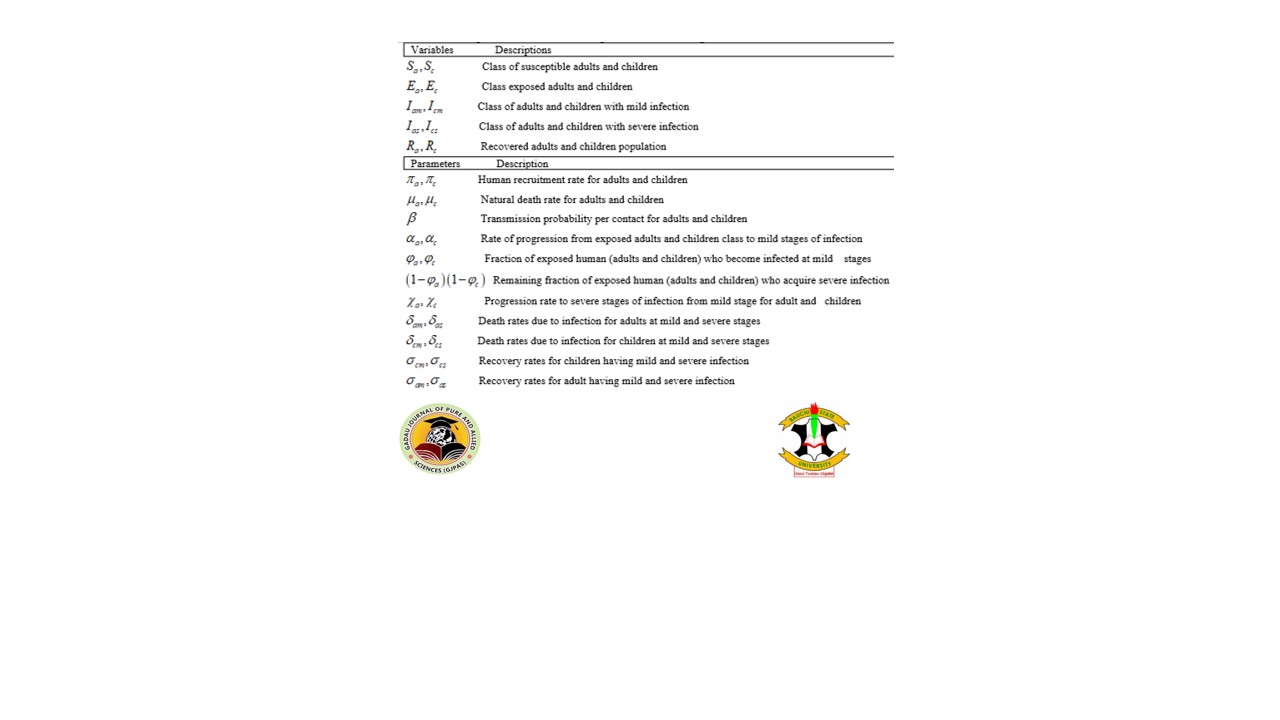Basic reproduction number and sensitivity analysis of Legionnaires’ disease model
DOI:
https://doi.org/10.54117/gjpas.v2i1.60Keywords:
Legionnaires’ model, Reproduction number, Sensitivity analysis, Pneumonia, DiseaseAbstract
Legionnaires’ disease is a very serious type of pneumonia (lung infection) caused by bacteria called Legionella. In this research, a mathematical model for the transmission dynamics of legionnaires’ is developed. Four different reproduction numbers were obtained indicating the type of interaction between susceptible and infected and how the disease is propagated between adults and children and vice versa. The research shows that using the human control reproduction number as response function, the sensitive parameters in the formulated system are the transmission probability, pubic enlighten awareness, modification parameter, progression rate, recover rate and natural mortality rate.
References
Beer, K.D., Gargano, J.W. and Roberts, V.A. (2012). Surveillance for waterborne disease outbreaks associated with drinking water—UnitedStates, 2011–2012. MMWR Morb Mortal Wkly Rep. 2015; 64(31):842–848.
Centers for Disease Control and Prevention (2011). Legionellosis—United States, 2000–2009. MMWR Morb Mortal Wkly Rep. 2011; 60(32):1083–108.
Chitnis, N., Hyman, J.M. and Cushing, J.M. (2008). Determined important parameters in the spread of malaria through the Sensitivity Analysis of a Mathematical Model. Bull. Math. Boil.70, 1272 – 1296 https://doi.org/10.1007/s11538-008-92099-0
Ebenezer, B. and Kazeem, O.K. (2016). Mathematical modeling of zika virus, Asian pacific journal of tropical Disease. 6(9):673-679.
Erinle, L. M. (2005). Mathematical model of temperature rise in three-layer skin during microwave hyperthermia. Journal of the Nigerian Association of Mathematical Physics, 9, 215-216.
Kathryn, L., Michael, S., Jorge, D.P., Keith, N., Suzanne, S. and Karin, L. (2018). A local of a mathematical model of coagulation and platelet deposition under flow vl-13 Do – 10.1371/journal.pone.0200917 Jo – plos ONE
Kelsie, C., Paul, G., Therese, R.E., Susan, M.C. and Daniel, M.W. (2019). Estimating the burden legionnaires’ Disease, American journal of epidemiology, 188(9), 1686-1694. https://doi.org/10.1098/aje/kwz142
Kizito, M., and Tumwiine, J. (2017). Modelling the role of treatment and vaccination in the control of transmission dynamics of pneumonia among children in Uganda, Paper presented at the 4th Strathmore International Mathematics Conference (SIMC 2017), 19 - 23 June 2017, Strathmore University, Nairobi, Kenya. http://hdl.handle.net/11071/10457
Mark, H.W., Alexis L.M. and Jade, M. (2019). An Advanced Risk Modeling Method to Estimate Legionellosis Risks Within a Diverse Population. http://www.mdpi.com/2073-4441/12/1/43/s1.
Ndelwa, E.J., Kgosimore, M., Massawe, E. S., and Namkinga, L. (2015). Mathematical modelling and analysis of treatment and screening of pneumonia. Mathematical Theory and Modeling, 5(10), 21-39.
Osman, S. and Makinde, O.D. (2018). A Mathematical Model for Co-Infection of Listeriosis and Anthrax Diseases. International Journal of Mathematics and Mathematical Sciences, Article ID: 1725671.
https://doi.org/10.1155/2018/1725671
Osman, S., Domitila, W. M. and Wainaina, M. (2018). Modelling and Analysis of Trypanosomiasis Transmission Mechanism, Global Journal of Pure and Applied Mathematics, 14(10):1311-1331.
Otieno, O.J., Mugisha, J. and Oleche, P. (2013). Mathematical Model for Pneumonia Dynamics with Carriers. Int. Journal of Math. Analysis, 7(50), 2457 – 2473.
Otoo, D., Opoku, P., Charles, S. and Kingsley, A.P. (2019). Deterministic epidemic model for (SVCSyCAsyIR) pneumonia dynamics, with vaccination and temporal immunity. Infectious Disease modelling, 5, 42-60.
Wee, B.A., Alves, J., Lindasy, D.S.J., Klatt, A.B., Sargison, F.A., Cameron, R.L., Pickering, A., Gorznski, L., Corander, J., Marttinen, P., Opitz, B., Smith, A.J. and Fitzgerald, J.R. (2021). Population analysis of legionella pneumophila reveals a basis for resistance to complement-mediated killing. Nature communications. 12(1), 7165. https://doi.org/10.1038/s41467-021-27478-z
Wei, F.K., Jann, T.W., Wang, H.S. and Yee, C.C. (2019). Community-acquired Legionnaires disease at medical center in northern Taiwan. Journal of microbiology, immunology and infection. 52(3), 465-470. https://doi.org/10.1016/j.jmii.2017.08.018
World Health Organization (2022). Legionella and prevention of Legionellosis (Geneva: world health organization; 2007),
ISBN 92 4 156297 8 (NLM classification: WC 200), Publications of the World Health Organization can be obtained from WHO Press, World
Health Organization, 20 Avenue Appia, 1211 Geneva 27, Switzerland.
Yaslianifard, S., Mobarez, A.M., Fatolahzadeh, B., and Feizabadi, M.M. (2012). Colonization of hospital water systems by Legionella pneumophila, Pseudomonas aeroginosa, and Acinetobacter in ICU wards of Tehran hospitals. Indian Journal of Pathology & Microbiology, 55(3), 352–356. https://doi.org/10.4103/0377-4929.101743.
Yustina, A., Liana, Nyimvua, S., Goodluck, M., and Anitha, P. (2020). African Trypanosomisis Dynamics: Modelling the effects of treatment, Education, and Vector Trapping, international journal of mathematics and mathematical sciences, 2020, Article ID 3690472, 15 pages 2020, https://doi.org/10.1155/2020/3690472.

Downloads
Published
Issue
Section
License
Copyright (c) 2023 Gadau Journal of Pure and Allied Sciences

This work is licensed under a Creative Commons Attribution 4.0 International License.

